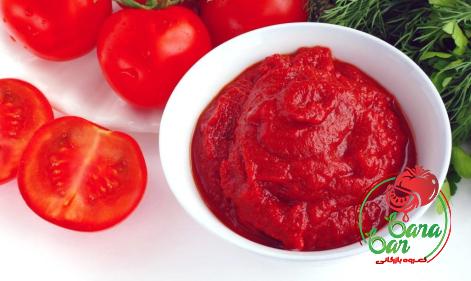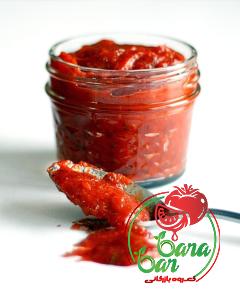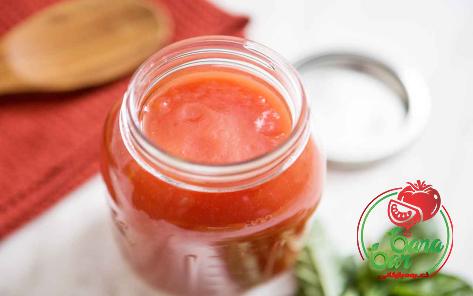Nothing quite captures the essence of summer like a juicy, ripe tomato. Whether you grow them in your backyard garden or pick them up at the local farmer’s market, tomatoes are a versatile fruit that can be used in a variety of dishes. One excellent way to make the most of your tomato harvest is by canning homemade tomato paste. Not only does this preserve the fresh flavor of tomatoes for months to come, but it also provides a pantry staple that can be used to enhance a wide range of culinary creations. In this comprehensive guide, we will explore everything you need to know about canning homemade tomato paste, from selecting the best tomatoes to the step-by-step canning process.

.
 ## Selecting the Best Tomatoes for Homemade Tomato Paste The key to making delicious homemade tomato paste is starting with the best tomatoes. While you can use any type of tomato for this process, plum or Roma tomatoes are often preferred due to their rich flavor and meaty texture. These varieties also have fewer seeds and less water content, resulting in a thicker paste. If you are growing your tomatoes, be sure to wait until they are fully ripe before harvesting for the best flavor. If you are purchasing tomatoes, look for ones that are firm, ripe, and free of blemishes. ## Preparing the Tomatoes for Canning Before you can begin the canning process, you will need to prepare the tomatoes. Start by washing them thoroughly to remove any dirt or debris. Next, blanch the tomatoes by placing them in boiling water for about 30 seconds, then immediately transferring them to an ice bath. This will make it easier to remove the skins. Once the tomatoes have cooled, peel off the skins and remove the cores. Chop the tomatoes into small chunks, discarding any bruised or overripe portions. ## Cooking the Tomato Paste To make tomato paste, you will need to cook down the tomatoes to concentrate their flavor. Place the chopped tomatoes in a large pot and cook over medium heat, stirring frequently to prevent sticking. As the tomatoes soften and release their juices, use a potato masher or immersion blender to break them down further. Continue cooking the tomatoes until they have reduced by about half and have a thick, paste-like consistency. This process can take several hours, so be patient and keep an eye on the mixture to prevent burning. ## Adding Flavorings While tomato paste is delicious on its own, you can enhance its flavor by adding herbs and spices during the cooking process. Common additions include garlic, onion, basil, oregano, and bay leaves. These ingredients not only add depth to the flavor of the paste but also help to preserve it during the canning process. Experiment with different combinations to create a tomato paste that suits your taste preferences.
## Selecting the Best Tomatoes for Homemade Tomato Paste The key to making delicious homemade tomato paste is starting with the best tomatoes. While you can use any type of tomato for this process, plum or Roma tomatoes are often preferred due to their rich flavor and meaty texture. These varieties also have fewer seeds and less water content, resulting in a thicker paste. If you are growing your tomatoes, be sure to wait until they are fully ripe before harvesting for the best flavor. If you are purchasing tomatoes, look for ones that are firm, ripe, and free of blemishes. ## Preparing the Tomatoes for Canning Before you can begin the canning process, you will need to prepare the tomatoes. Start by washing them thoroughly to remove any dirt or debris. Next, blanch the tomatoes by placing them in boiling water for about 30 seconds, then immediately transferring them to an ice bath. This will make it easier to remove the skins. Once the tomatoes have cooled, peel off the skins and remove the cores. Chop the tomatoes into small chunks, discarding any bruised or overripe portions. ## Cooking the Tomato Paste To make tomato paste, you will need to cook down the tomatoes to concentrate their flavor. Place the chopped tomatoes in a large pot and cook over medium heat, stirring frequently to prevent sticking. As the tomatoes soften and release their juices, use a potato masher or immersion blender to break them down further. Continue cooking the tomatoes until they have reduced by about half and have a thick, paste-like consistency. This process can take several hours, so be patient and keep an eye on the mixture to prevent burning. ## Adding Flavorings While tomato paste is delicious on its own, you can enhance its flavor by adding herbs and spices during the cooking process. Common additions include garlic, onion, basil, oregano, and bay leaves. These ingredients not only add depth to the flavor of the paste but also help to preserve it during the canning process. Experiment with different combinations to create a tomato paste that suits your taste preferences.
..
 ## Canning Tomato Paste Once the tomato paste has reached the desired consistency, it is time to can it for long-term storage. Here is a step-by-step guide to canning homemade tomato paste: 1. Sterilize the jars: Wash the canning jars, lids, and bands in hot, soapy water and rinse them thoroughly. Place the jars in a large pot of boiling water and boil for 10 minutes to sterilize them. Keep the jars hot until ready to use. 2. Fill the jars: Ladle the hot tomato paste into the sterilized jars, leaving about ¼ inch of headspace at the top. Wipe the rims of the jars with a clean, damp cloth to remove any residue. 3. Seal the jars: Place the lids on the jars and screw on the bands until fingertip-tight. Do not overtighten the bands, as this can prevent air from escaping during the canning process. 4. Process the jars: Place the filled jars in a water bath canner or pressure canner, making sure they are covered by at least 1 inch of water. Process the jars according to the recommended time and pressure for your altitude and the size of the jars. 5. Cool and store: Once the jars have been processed, carefully remove them from the canner and place them on a towel-lined countertop to cool. As the jars cool, you may hear the lids pop, indicating that they have sealed properly. Store the cooled jars in a cool, dark place for up to 12 months. ## Using Homemade Tomato Paste Homemade tomato paste adds a rich depth of flavor to a wide range of dishes, from soups and stews to pasta sauces and marinades. When using homemade tomato paste, a little goes a long way, so start with a small amount and taste as you go. You can also freeze leftover tomato paste in ice cube trays for easy portioning in future recipes. ## Benefits of Canning Homemade Tomato Paste Canning homemade tomato paste is a great way to preserve the flavor of fresh tomatoes for year-round use. Unlike store-bought tomato paste, which often contains added preservatives and sugars, homemade tomato paste is made from pure, natural ingredients. By canning your own tomato paste, you can control the quality of the ingredients and tailor the flavor to your liking. Additionally, canning allows you to use up an abundant tomato harvest and reduce food waste. ## In Conclusion Canning homemade tomato paste is a rewarding process that allows you to enjoy the flavors of summer long after the season has ended. By following the steps outlined in this guide and experimenting with different tomato varieties and flavorings, you can create a pantry staple that will elevate your cooking to new heights. Whether you are a seasoned canner or new to the process, making homemade tomato paste is a fun and delicious way to preserve the bounty of the tomato harvest. So grab your apron, roll up your sleeves, and get canning!
## Canning Tomato Paste Once the tomato paste has reached the desired consistency, it is time to can it for long-term storage. Here is a step-by-step guide to canning homemade tomato paste: 1. Sterilize the jars: Wash the canning jars, lids, and bands in hot, soapy water and rinse them thoroughly. Place the jars in a large pot of boiling water and boil for 10 minutes to sterilize them. Keep the jars hot until ready to use. 2. Fill the jars: Ladle the hot tomato paste into the sterilized jars, leaving about ¼ inch of headspace at the top. Wipe the rims of the jars with a clean, damp cloth to remove any residue. 3. Seal the jars: Place the lids on the jars and screw on the bands until fingertip-tight. Do not overtighten the bands, as this can prevent air from escaping during the canning process. 4. Process the jars: Place the filled jars in a water bath canner or pressure canner, making sure they are covered by at least 1 inch of water. Process the jars according to the recommended time and pressure for your altitude and the size of the jars. 5. Cool and store: Once the jars have been processed, carefully remove them from the canner and place them on a towel-lined countertop to cool. As the jars cool, you may hear the lids pop, indicating that they have sealed properly. Store the cooled jars in a cool, dark place for up to 12 months. ## Using Homemade Tomato Paste Homemade tomato paste adds a rich depth of flavor to a wide range of dishes, from soups and stews to pasta sauces and marinades. When using homemade tomato paste, a little goes a long way, so start with a small amount and taste as you go. You can also freeze leftover tomato paste in ice cube trays for easy portioning in future recipes. ## Benefits of Canning Homemade Tomato Paste Canning homemade tomato paste is a great way to preserve the flavor of fresh tomatoes for year-round use. Unlike store-bought tomato paste, which often contains added preservatives and sugars, homemade tomato paste is made from pure, natural ingredients. By canning your own tomato paste, you can control the quality of the ingredients and tailor the flavor to your liking. Additionally, canning allows you to use up an abundant tomato harvest and reduce food waste. ## In Conclusion Canning homemade tomato paste is a rewarding process that allows you to enjoy the flavors of summer long after the season has ended. By following the steps outlined in this guide and experimenting with different tomato varieties and flavorings, you can create a pantry staple that will elevate your cooking to new heights. Whether you are a seasoned canner or new to the process, making homemade tomato paste is a fun and delicious way to preserve the bounty of the tomato harvest. So grab your apron, roll up your sleeves, and get canning!
…
 ## Safety Considerations for Canning Homemade Tomato Paste While canning homemade tomato paste is a relatively simple process, it is essential to follow proper safety guidelines to ensure that your canned goods are safe to consume. Here are some important safety considerations to keep in mind: ### Use the Right Equipment When canning tomato paste, it is crucial to use the appropriate equipment, such as a water bath canner or pressure canner. These tools help to create a vacuum seal that prevents the growth of harmful bacteria. Be sure to check that your canning equipment is in good condition and functioning correctly before use. ### Follow Canning Recipes It is essential to follow tested canning recipes when making tomato paste. These recipes have been developed to ensure that the acidity levels in the paste are high enough to prevent the growth of botulism-causing bacteria. Do not alter the ingredients or proportions in canning recipes, as this can affect the safety and shelf life of the finished product. ### Check Altitude Adjustments If you live at a high altitude, you may need to make adjustments to your canning process to ensure that the jars are properly sealed. Be sure to follow altitude-adjusted processing times and pressures to maintain the safety of your canned tomato paste. ### Monitor Seal Integrity After processing the jars, it is essential to check that they have sealed correctly. You can do this by pressing down on the center of the lid – if it does not flex or make a popping noise, the jar has sealed properly. Any jars that have not sealed should be refrigerated and used promptly. ### Storage and Shelf Life Properly canned tomato paste should be stored in a cool, dark place and used within one year for the best quality. Check the jars periodically for any signs of spoilage, such as bulging lids, off odors, or discoloration. If you notice any of these signs, do not consume the contents of the jar. ## Conclusion Canning homemade tomato paste is a rewarding and practical way to preserve the flavors of summer for year-round enjoyment. By following the steps outlined in this guide and adhering to safety guidelines, you can create a delicious and versatile pantry staple that will enhance your cooking endeavors. Experiment with different tomato varieties, herbs, and spices to create a tomato paste that is uniquely your own. Whether you use it as a base for pasta sauces, soups, or marinades, homemade tomato paste is sure to elevate the flavors of your dishes and bring a taste of summer to every meal. So roll up your sleeves, embrace the canning process, and savor the fruits of your labor with each jar of homemade tomato paste you create. Happy canning!
## Safety Considerations for Canning Homemade Tomato Paste While canning homemade tomato paste is a relatively simple process, it is essential to follow proper safety guidelines to ensure that your canned goods are safe to consume. Here are some important safety considerations to keep in mind: ### Use the Right Equipment When canning tomato paste, it is crucial to use the appropriate equipment, such as a water bath canner or pressure canner. These tools help to create a vacuum seal that prevents the growth of harmful bacteria. Be sure to check that your canning equipment is in good condition and functioning correctly before use. ### Follow Canning Recipes It is essential to follow tested canning recipes when making tomato paste. These recipes have been developed to ensure that the acidity levels in the paste are high enough to prevent the growth of botulism-causing bacteria. Do not alter the ingredients or proportions in canning recipes, as this can affect the safety and shelf life of the finished product. ### Check Altitude Adjustments If you live at a high altitude, you may need to make adjustments to your canning process to ensure that the jars are properly sealed. Be sure to follow altitude-adjusted processing times and pressures to maintain the safety of your canned tomato paste. ### Monitor Seal Integrity After processing the jars, it is essential to check that they have sealed correctly. You can do this by pressing down on the center of the lid – if it does not flex or make a popping noise, the jar has sealed properly. Any jars that have not sealed should be refrigerated and used promptly. ### Storage and Shelf Life Properly canned tomato paste should be stored in a cool, dark place and used within one year for the best quality. Check the jars periodically for any signs of spoilage, such as bulging lids, off odors, or discoloration. If you notice any of these signs, do not consume the contents of the jar. ## Conclusion Canning homemade tomato paste is a rewarding and practical way to preserve the flavors of summer for year-round enjoyment. By following the steps outlined in this guide and adhering to safety guidelines, you can create a delicious and versatile pantry staple that will enhance your cooking endeavors. Experiment with different tomato varieties, herbs, and spices to create a tomato paste that is uniquely your own. Whether you use it as a base for pasta sauces, soups, or marinades, homemade tomato paste is sure to elevate the flavors of your dishes and bring a taste of summer to every meal. So roll up your sleeves, embrace the canning process, and savor the fruits of your labor with each jar of homemade tomato paste you create. Happy canning!










Your comment submitted.